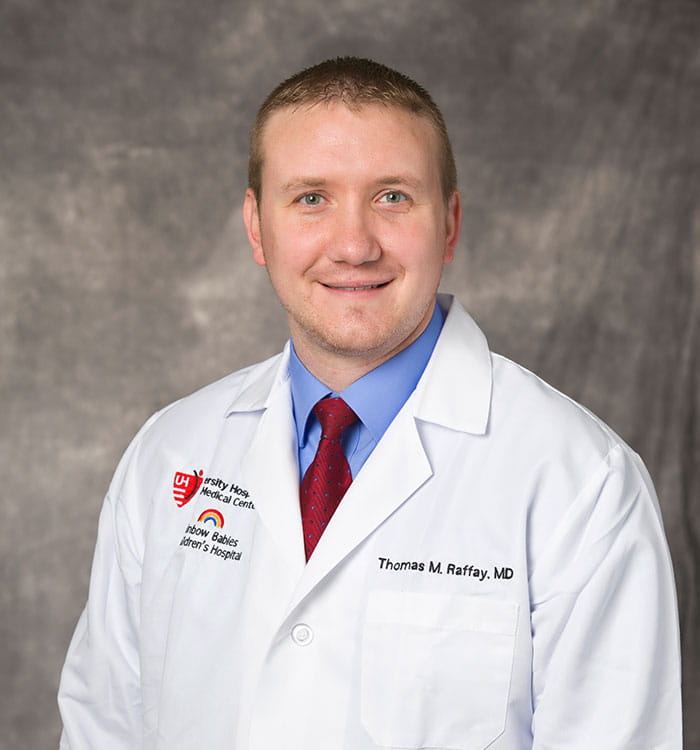UH Rainbow Researchers Identify New Therapeutic Target for Treating or Preventing Bronchopulmonary Dysplasia in Preterm Infants
December 01, 2021

GSNOR is also being targeted in clinical trials of asthma and cystic fibrosis
Innovations in Pediatrics | Winter 2022
Researchers at UH Rainbow Babies & Children’s Hospital have identified a gene that may play a pivotal role in the development of bronchopulmonary dysplasia (BPD) in premature infants treated with oxygen in the NICU – especially with regard to the complication of pulmonary hypertension.
 Thomas Raffay, MD
Thomas Raffay, MDUsing a newborn mouse model, the team found that mice lacking the gene adh5 in all their tissues – “global knockout mice” -- did not develop the lung, airway and pulmonary hypertension problems associated with BPD. However, mice that were lacking the gene in only their smooth muscle tissue -- “conditional knockout mice” -- were protected from pulmonary hypertension alone, suggesting an important role for the gene in the smooth muscle in this particular complication.
A key component in this process seems to be S-nitrosoglutathione (GSNO), says Thomas M. Raffay, MD, principal investigator on the project and a neonatologist at UH Rainbow.
“In previous work, we have shown that the GSNO catabolic enzyme encoded by adh5 -- GSNO reductase (GSNOR) -- is upregulated in hyperoxia, which we use to simulate the conditions in the NICU,” he says. “We also found that both pre-treatment with aerosolized GSNO and inhibition of GSNOR attenuated airway hyperresponsiveness among juvenile and adult mice exposed to neonatal hyperoxia. Both things were protective of the airway component. Now we’ve gone on to create mice that weren’t able to express the enzyme from birth, and we found that it, too, was protective. These findings point to a possible role for GSNOR as a novel target for future BPD therapies. GSNO-mimetic agents or GSNOR inhibitors, both of which are currently in clinical trials for other conditions, could be considered for further study in BPD.”
The need for better therapies for BPD is great, Dr. Raffay says.
“Infants and children with BPD continue to have both increased mortality and prolonged, expensive hospital stays,” he says. “Bronchospastic obstructive airway disease persists into adulthood, and there are approximately 1 million BPD survivors in the United States. Unfortunately, no effective BPD therapies have been developed for decades.”
Dr. Raffay and his team published their findings recently in the American Thoracic Society Red Journal.
For the current study, Dr. Raffay and his team also studied samples of human lung tissue from infants and children with and without BPD, conducting blinded comparisons of GSNOR protein expression.
“GSNOR was prominently expressed in the airways and vessels of human BPD subjects,” he says. “Compared with controls, expression was greater in BPD smooth muscle, particularly in vascular smooth muscle. The findings in human infant lung specimens were consistent with the murine data, suggesting that GSNOR has a central role— and could be a new target in the treatment of BPD-associated pulmonary hypertension.”
In fact, clinical trials evaluating GSNOR inhibitors are currently under way with patients with asthma and cystic fibrosis. UH Rainbow Babies & Children’s Hospital was part of the GSNOR inhibitor trial for cystic fibrosis and is currently studying inhaled GSNO with James Reynolds, PhD, Professor of Anesthesiology & Perioperative Medicine at Case Western Reserve University and a Harrington Scholar with the Harrington Discovery Institute at University Hospitals. Given this and the strength of his recent data, Dr. Raffay says he’s cautiously optimistic that these agents will eventually be studied in a clinical trial with BPD patients. In the meantime, he and his colleagues are continuing their work to detail the specific molecular pathway at work in BPD.
“We know those cells that coat all the lining of the airway and the muscle behind it express a lot of GSNOR,” he says. “In the conditional knockout mice, they were still expressing it there and it could be why they weren’t protected from BPD complications. Our next step is to delete the gene from the epithelium and see if it’s protective of the lung changes and the airway changes that we didn’t see, and we’ll also look to see if the pulmonary hypertension changes are there. We also want to find out if indeed we can use this GSNOR inhibitor longer-term to protect the animals. If we can come up with an optimized treatment in the mice, it would be important information to be sent to the FDA for any potential clinical trial.”
For more information about this research, please email Peds.Innovations@UHhospitals.org.
Contributing Expert:
Thomas M. Raffay, MD
Neonatologist
UH Rainbow Babies & Children's Hospital
Assistant Professor
Case Western Reserve University School of Medicine


